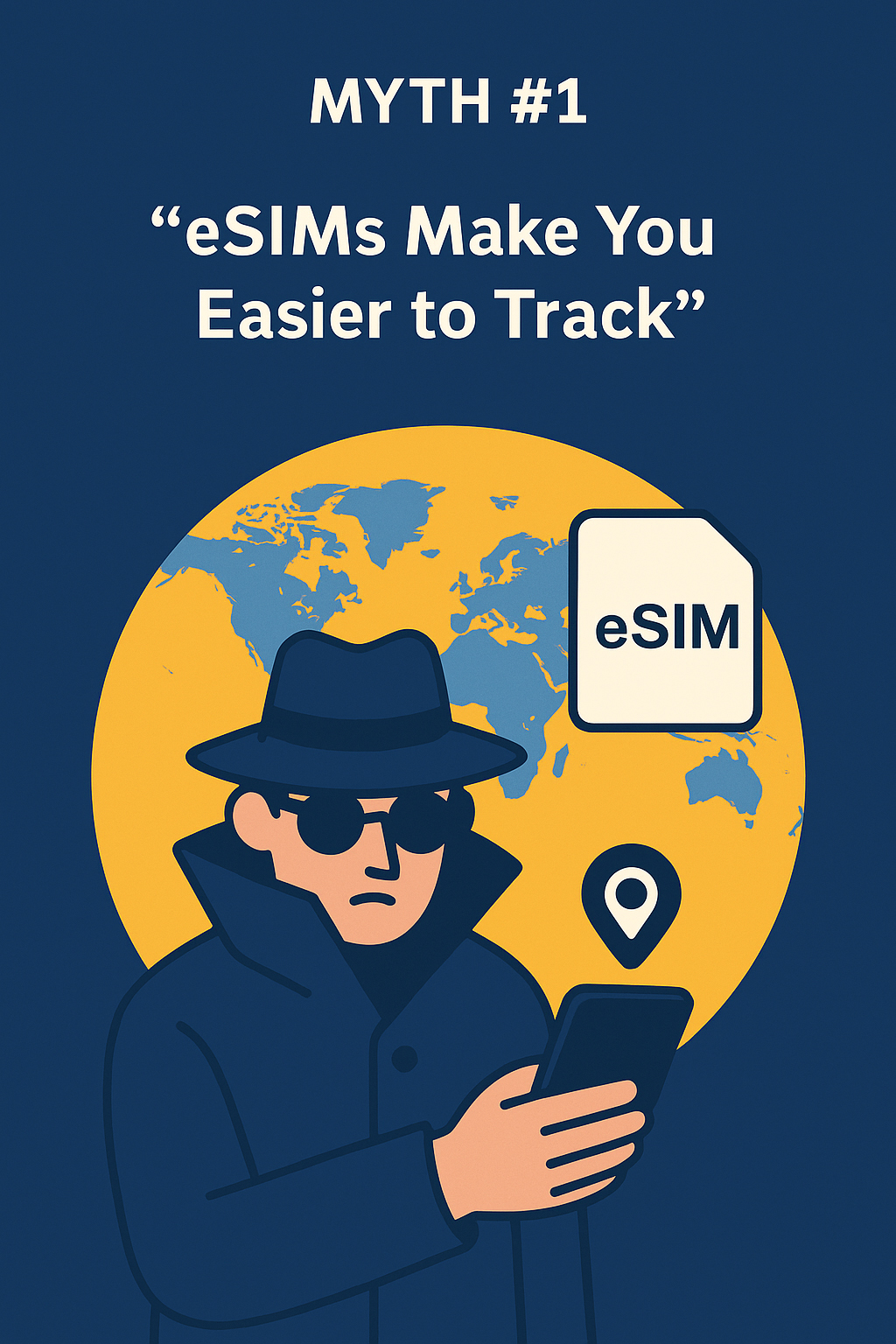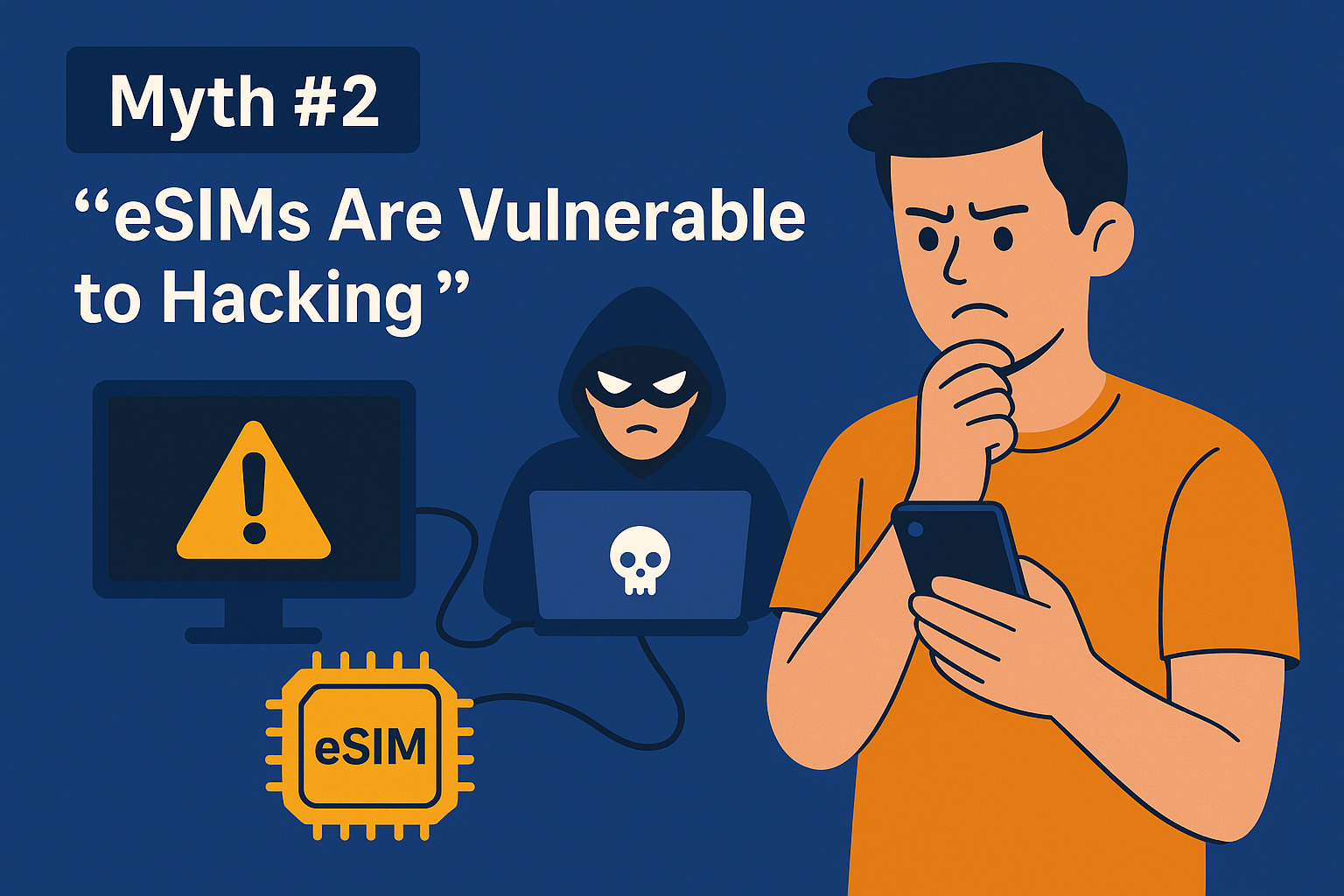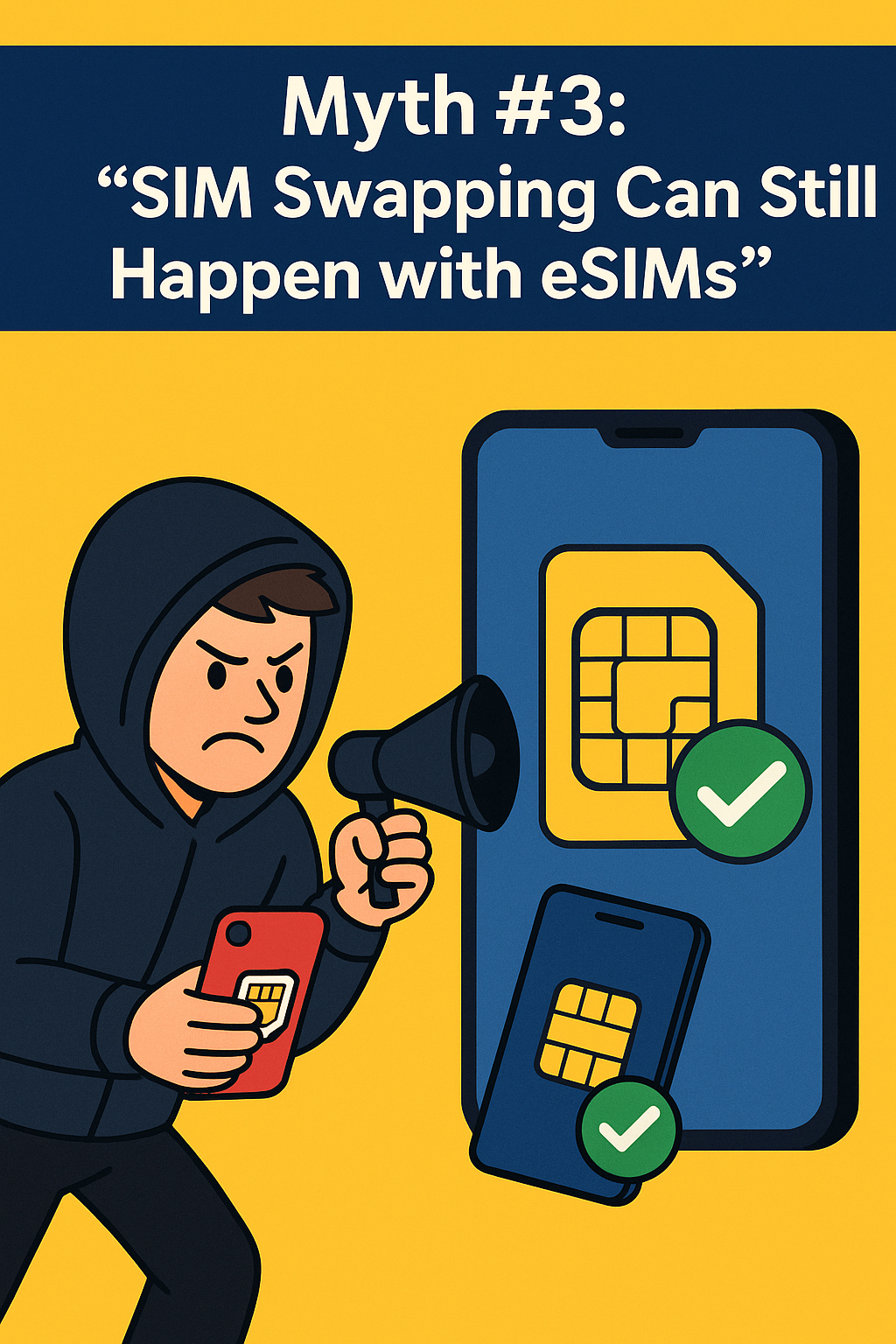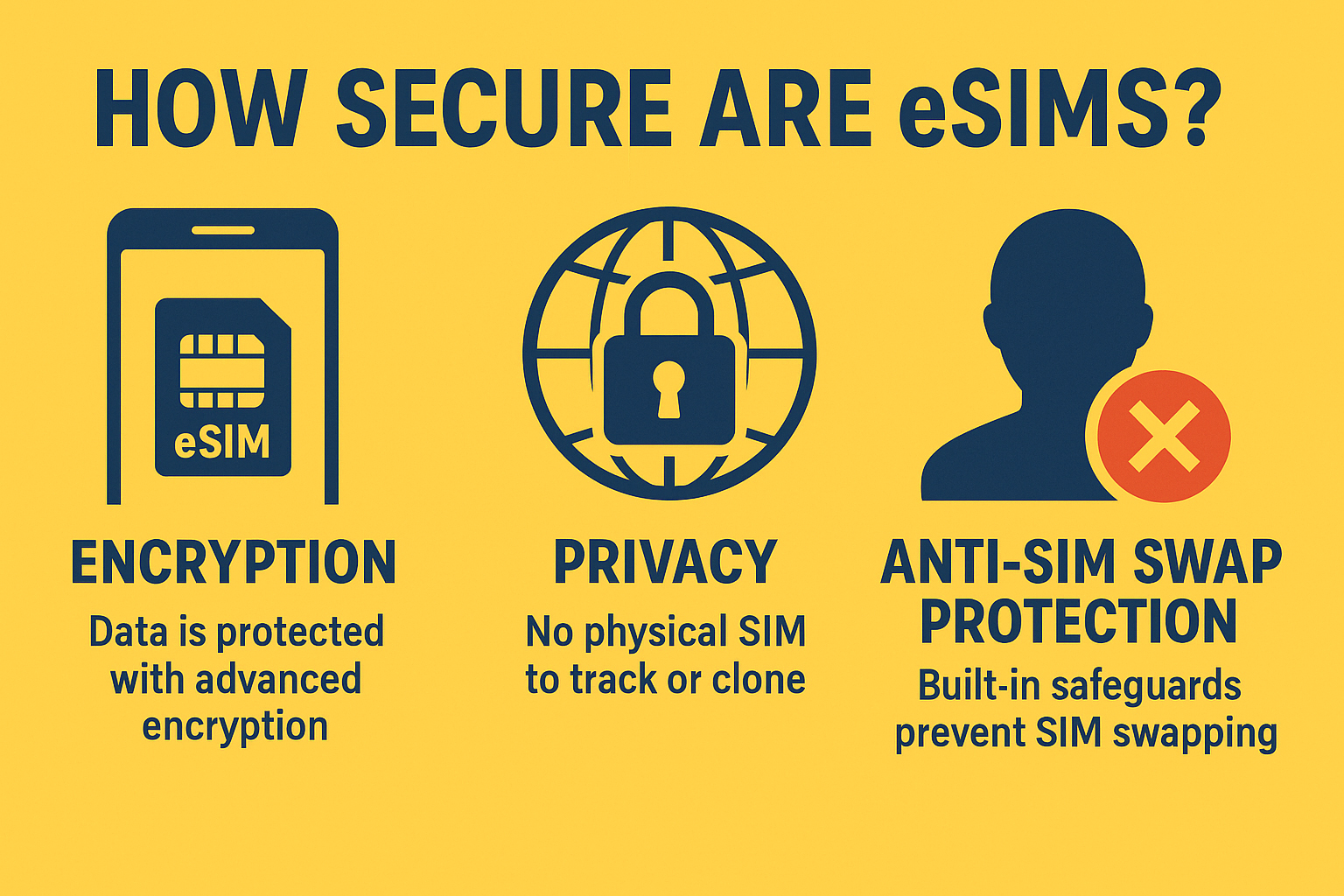Privacy, Encryption, and SIM Swapping Myths — Explained
As travelers continue switching from plastic SIM cards to digital eSIMs, one question comes up again and again: “Are eSIMs secure?”
The short answer: Yes — eSIMs are not only secure, they’re significantly safer than traditional SIM cards.
But like any digital tool, understanding how eSIM security works — and what threats to look out for — is essential, especially for travelers moving between countries, Wi-Fi networks, and mobile carriers.
This guide breaks down the privacy protections, encryption technology, and myths surrounding eSIMs so you can travel smarter and stay connected with confidence.
What Is an eSIM, and Why Is It More Secure?
An eSIM (embedded SIM) is a rewritable chip built directly into your smartphone, tablet, or IoT device. Unlike a removable SIM card, an eSIM can’t be physically swapped, stolen, or cloned without your knowledge.
Instead of inserting a chip, you download a secure digital profile from your carrier or provider — like OneSimCard — and activate it instantly.
Why That Matters for Security
-
No physical access: Thieves can’t remove or replace your eSIM like a traditional SIM.
-
Encrypted provisioning: Each eSIM profile is delivered over an encrypted connection, verified by the device’s secure element.
-
Tamper-resistant hardware: eSIMs live inside a protected chip that’s isolated from the operating system, reducing the risk of malware access.
-
Carrier-verified identities: Every eSIM profile comes with a digital signature that ensures authenticity.
Essentially, an eSIM eliminates the most common source of SIM fraud — physical manipulation.
Encryption: How eSIMs Keep Your Data Private
Every time your phone connects to a network, the eSIM uses advanced encryption and mutual authentication to verify both your device and the carrier’s system.
Here’s what that means in plain English:
-
Mutual authentication ensures that only legitimate networks can communicate with your device — and vice versa.
-
128-bit or higher encryption scrambles your mobile identity and data so that it’s unreadable to outsiders.
-
Remote profile management happens through secure carrier channels, protected by digital certificates.
So, even if you’re on a public airport Wi-Fi or connecting through roaming networks abroad, your mobile identity and data remain encrypted.
️ Myth #1: “eSIMs Make You Easier to Track”
Myth #1: “eSIMs Make You Easier to Track”
This is a common misconception, but eSIMs do not make you more traceable than physical SIMs.
Mobile carriers always require an identifier (IMSI) to route calls and data — that’s true for both SIM and eSIM devices. What changes with eSIM is control:
-
You can switch providers instantly without disclosing new personal data to multiple stores or resellers.
-
OneSimCard’s eSIMs use multiple international identities, minimizing the sharing of your real number across borders.
-
Because there’s no physical SIM, third-party data brokers or thieves can’t clone or read your SIM details.
In fact, many privacy-focused travelers prefer eSIMs because they reduce the number of entities handling your data.
 Myth #2: “eSIMs Are Vulnerable to Hacking”
Myth #2: “eSIMs Are Vulnerable to Hacking”
In reality, eSIMs have more layers of security than removable SIMs.
Traditional SIMs can be cloned, stolen, or compromised via phishing. eSIMs, by contrast, require several things to go wrong simultaneously:
-
Physical access to your device
-
Device passcode bypass
-
Carrier authentication override (protected by certificates)
Each of these layers includes encryption and identity verification, making successful attacks extremely unlikely.
To date, there are no known large-scale eSIM hacks. By design, eSIMs comply with stringent GSMA security standards — the same framework used by global carriers and banks for digital authentication.
 Myth #3: “SIM Swapping Can Still Happen with eSIMs”
Myth #3: “SIM Swapping Can Still Happen with eSIMs”
SIM swapping — where hackers trick a carrier into transferring your number to their SIM — has become a serious problem in recent years.
However, eSIM technology dramatically reduces that risk.
Here’s why:
-
Carriers use multi-factor verification before transferring eSIM profiles.
-
Every eSIM installation must be authorized from your device, often requiring biometrics or a passcode.
-
Profiles can’t be downloaded or duplicated without your device’s unique identifier (EID).
In other words, even if a hacker convinces a carrier to create a new eSIM profile, they’d still need your phone’s secure hardware to activate it.
For travelers, this means your mobile identity is safer in digital form than plastic form.
Real-World Travel Scenarios: How eSIMs Protect You
✈️ Airport SIM Swaps — Eliminated
In the past, travelers had to buy local SIMs from kiosks, handing over passports and personal info. eSIMs remove that exposure — everything happens securely online through trusted providers like OneSimCard.
Public Wi-Fi Attacks — Minimized
When you connect via eSIM, your cellular data bypasses unencrypted Wi-Fi risks entirely. That’s critical when checking banking apps or booking flights from airports and hotels.
Lost or Stolen Phones
Even if someone steals your device, your eSIM can’t be removed and resold. You can remotely disable or wipe the profile using Apple’s “Find My” or Android’s “Find My Device.”
Cross-Border Roaming
With OneSimCard’s multi-network redundancy, your eSIM automatically connects to the most secure available partner — no need to switch SIMs or trust local vendors.
How eSIMs Handle Personal Data
All eSIM provisioning is governed by GSMA’s Remote SIM Provisioning (RSP) standard, which defines exactly how your profile is created, stored, and deleted.
Key security principles include:
-
End-to-end encryption: No one — not even the carrier — can view your actual authentication keys.
-
Secure profile storage: eSIM data lives inside a hardware-based “secure enclave,” isolated from apps or system files.
-
Controlled access: Only authorized carriers can send updates or delete profiles.
When you delete a OneSimCard eSIM profile, the system erases it from both your device and the carrier database — no lingering data remains.
Traveler Tips for Maximum eSIM Security
Even with built-in protections, good digital hygiene goes a long way:
-
Use a reputable provider — Stick with established brands like OneSimCard that comply with GSMA and GDPR privacy regulations.
-
Lock your device — Enable biometric login (Face ID, fingerprint, or PIN).
-
Don’t share your QR code — Treat your eSIM activation code like a password.
-
Update regularly — Keep your phone’s OS current to ensure the latest security patches.
-
Avoid sketchy networks — Rely on your eSIM’s cellular data instead of public Wi-Fi when handling sensitive info.
The Bottom Line: eSIMs Are Safer Than Traditional SIMs
For travelers, eSIMs are a leap forward in both convenience and protection. The combination of hardware-level encryption, remote management, and tamper-proof provisioning makes them a powerful shield against modern threats like SIM swapping, phishing, and data theft.
When you travel with a OneSimCard eSIM, your connectivity is not just global — it’s secure by design. You control your data, your identity, and your network access from anywhere in the world.
✅ Final Takeaway
Are eSIMs secure? Absolutely.
Are they safer than traditional SIMs? Without a doubt.
For travelers who value privacy and peace of mind, an eSIM offers the most secure way to stay connected across borders.
Stay Secure — Stay Connected
Your journey shouldn’t come with security compromises.
Activate your OneSimCard eSIM today and enjoy global data, privacy, and confidence — wherever you roam.


